
Sir Clive Sinclair's ZX Spectrum is one of the most talked-about and influential home computers the world has ever seen, despite its commercial reach being mostly limited to the United Kingdom. With around five million units sold during its lifetime – and playing host to thousands of games – the ZX Spectrum launched the careers of countless bedroom coders and created a generation of devoted gamers.
We've seen multiple attempts to capitalise on the deep-rooted nostalgia that exists for this venerable home micro – including the ill-fated ZX Vega+ and the somewhat more successful Spectrum micro-console – but arguably the most promising revival of this legendary system is the ZX Spectrum Next, an FPGA-powered replica that began life in Brazil over a decade ago before coming to market via Kickstarter in 2017.
While the initial crowdfunding campaign wasn't as successful as it was hoped, a second offering – launched in 2020 – raised a staggering £1,847,106, effortlessly blasting past its comparatively modest £250,000 funding goal. A third Kickstarter is currently live and looks set to overtake the second; it is fast approaching £2 million in pledges, with a starting price of £300 (upgrade options for existing Next owners are also available).
SpecNext, the company behind the system, were kind enough to supply me with a review sample of the ZX Spectrum Next, taken from the second Kickstarter campaign. While there are technical differences between this model and the one that is currently being funded – which I'll come to shortly – SpecNext boss Henrique Olifiers has already stated that everything that works on the 'third issue' model will work on the previous editions; the exceptions will be unofficial software created by the community which seeks to leverage the third issue's larger FPGA chip.
ZX Spectrum Next Review: Design
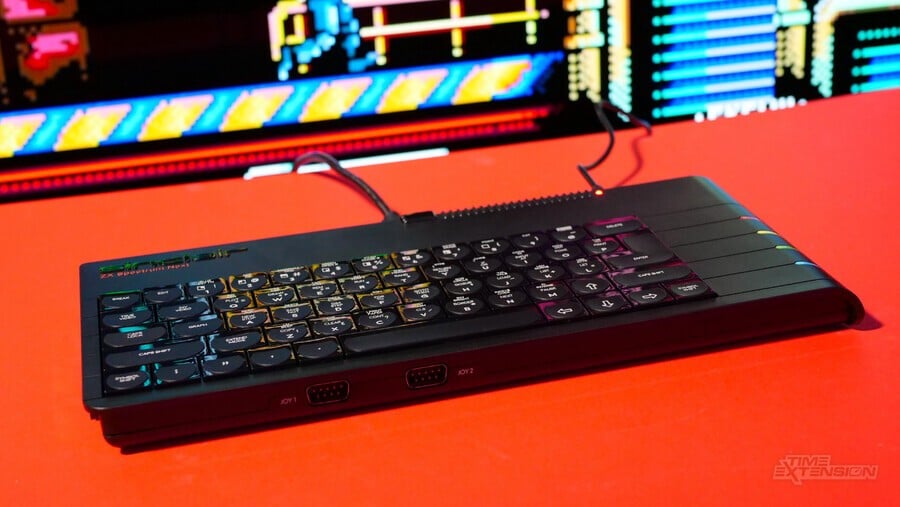
The case of the ZX Spectrum Next was designed by the late Rick Dickinson, who worked at Sinclair Research Ltd in the '80s and is responsible for the look and feel of the ZX81 and Sinclair QL, as well as the original ZX Spectrum design, complete with its iconic rubber membrane keyboard. Dickinson sadly passed away in 2018 and therefore wasn't around to see his new creation fully take flight, but his involvement means the ZX Spectrum Next carries that all-important Sinclair design DNA.
From the gloriously tactile keyboard (which takes inspiration from the one seen on the aforementioned QL) to the subtle rainbow colours embedded into the curved right-hand section of the device, this looks and feels just as you'd expect a new Spectrum computer to; it manages to marry the past with the present in a way which is both aesthetically pleasing and practical from a user experience standpoint.
On the back of the ZX Spectrum Next, you'll find a power socket, HDMI port, two 3.5mm audio jacks (one of which is a combined MIC and EAR port for loading and saving on tape), an RGB/VGA port and a PS/2 port for connecting a keyboard or mouse. There's sadly no USB-A port, so you can't connect keyboards, mice or controllers that way; this is an authentic approach, to be sure, but one which might frustrate some owners (a clever workaround does exist, however – which I'll come to shortly).
On the model I was sent, there are additional Micro USB ports which are blanked off; these come into action if you install the optional Raspberry Pi Zero 'accelerator' board. There's also an external bus expansion port which allows you to connect original ZX Spectrum add-on hardware, like the +3 disk interface.
On the left-hand side, there's a Reset button (red), Drive button (green), SD card slot and NMI button (yellow). The latter is interesting for reasons we'll come to in the next section of the review; in short, it allows you to boost the clock speed of the system with 3.5MHz, 7MHz, 14MHz, and 28MHz options available.
The front of the ZX Spectrum Next is bare aside from two DB9 joystick ports, which allow you to plug in original controllers. My favourite option is the Mega Drive pad, as this offers support for Next titles which use more than one button. As I mentioned just a second ago, you can't connect USB-A controllers directly to the Next, but you can use 8BitDo's MegaDrive/Genesis Retro Receiver to pair PS4, Xbox One and even Wii Remote controllers via Bluetooth.
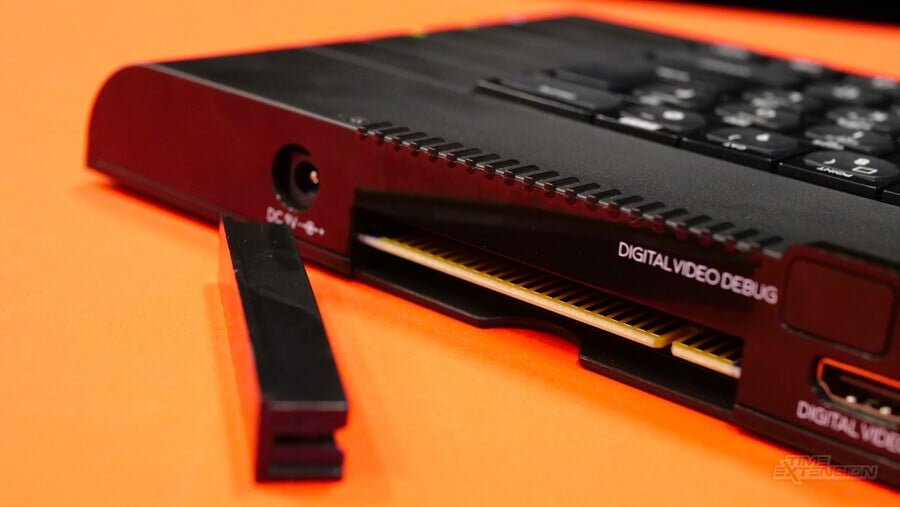
One thing to note is that the ZX Spectrum Next doesn't have a power button, just like the original home micro – it turns on the moment you insert the power cable. There's a power switch attachment included in the box (it fits between the power cable and the Next's power socket and allows you to turn it on and off), but the one included with my review sample was quite temperamental, suggesting that the wire had snapped inside the cable. I ended up simply unplugging the cable when I wanted to power off the system.
ZX Spectrum Next Review: Software
The ZX Spectrum Next comes with NextZXOS on its SD card, a feature-rich imitation of the Spectrum's OS coded by Garry Lancaster. Lancaster also contributes the extended BASIC interpreter NextBASIC.
The system comes with a weighty, ring-bound manual that goes into intimate detail about all of the coding tricks you can perform using the bundled software. I dare say the vast majority of casual users will just want to play games, which is easy enough to do using the NextZXOS interface. However, as well all know, the computer's legacy is that it inspired thousands of people to take up programming, so it's great that this new model keeps that tradition alive – for those who wish to embrace it (you can also load up Sinclair BASIC, if that's more your bag).
To that end, an impressive suite of community-coded homebrew apps has appeared; you can browse some of them here.
As part of the Issue 3 crowdfunding campaign, it has been confirmed that the Next will be getting access to alternative FPGA cores (referred to as "Personalities") that allow it to behave like other home computers, including the Commodore 64 and Sinclair QL.
Should the campaign reach all of its stretch goals, we could also see Amstrad CPC support added, making the system even more appealing.
ZX Spectrum Next Review: Hardware & Performance
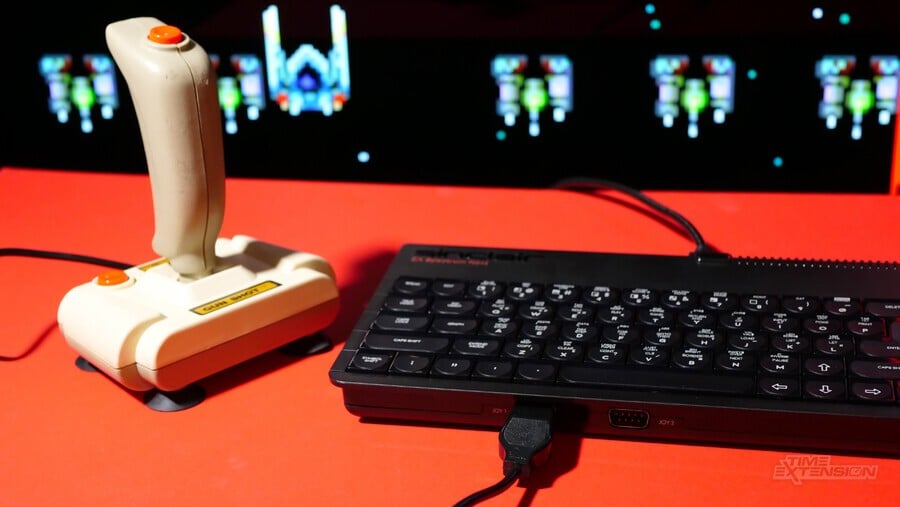
The original 'issue one' ZX Spectrum Next was powered by the Xilinx Spartan-6 FPGA, while the second model was upgraded to the more capable Xilinx Artix-7 XC7A15T FPGA. The third model will use the Artix A7 XC7A35T-2CSG324C, making it the most powerful of the three editions.
This might lead some early adopters to grumble that they have been relegated to second (or even third, if you got the debut model) class citizens as a result, but Henrique Olifiers insists this isn't the case.
"This is a core tenet of the project: anything we do has to run on Issues 1 & 2, there’s no obsolescence, period," he told me a short time ago. "That said, people will make use of the extra room in the FPGA, there’s no stopping that, and rightly so. But the litmus test goes like this: let’s take the Sinclair QL core for example. The QL core runs on all three machines. But if someone implements, say, a 68882 math co-processor, it’s likely it will only fit in the Issues 2 & 3. The original Issue 1 will still be able to run all the QL software out there, but the Issues 2 & 3 will run it faster. The ZX Spectrum Next Issue 3 will be able to implement a lot of neat features the Issue 1 & 2 won’t, but none of these features are required to run the games, apps and drivers that are released for the Next."
Even so, keep in mind that my impressions of the machine are based solely on the second issue model, powered by the Xilinx Artix-7 XC7A15T.
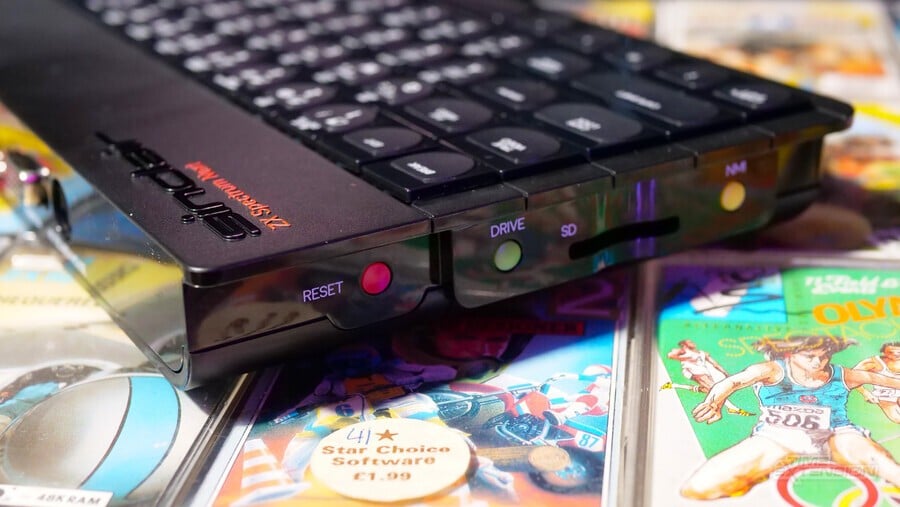
The good news is that, as a machine for replicating the performance of the ZX Spectrum, the Next goes way beyond any reasonable expectations. Not only can it run all ZX Spectrum games, but it's also capable of playing Sinclair ZX80 and ZX81 titles. You can either load these up instantly via your SD card or hook up a tape deck and load them the old-fashioned way.
Just running old Speccy games is only part of the story, however; the ZX Spectrum Next is also capable of running enhanced titles which make use of its additional power. Some of these new games – such as Vradark's Revenge, Magnum: Clean Shot, Aliens: Neoplasma 2, Delta's Shadow and Saboteur Remastered go way beyond what the original hardware was capable of in terms of visuals and audio. Granted, they're still not quite in the same ballpark as the best-looking Genesis or SNES games, but it's fascinating to see what 'enhanced' Spectrum games could have looked like had Sinclair not imploded in the '80s.
While I've been having a blast playing these 'neo classic' titles, I found myself returning to old-school Spectrum titles to see how the Next's 'turbo' modes impacted their performance. It's remarkable to see early 3D titles – which pushed the Speccy to its limits – run so smoothly; it makes them feel like brand-new remasters, if I'm honest. However, don't expect the turbo boosts to work consistently across all titles; some don't see dramatic improvements, while others become comically fast. Finding the sweet spot with the four different clock speed modes takes time, but it's worth the effort.
Oh, and don't sleep on the hordes of (non-Next) homebrew Spectrum games out there – Castlevania: Spectral Interlude is well worth a look.
It's worth pointing out that while it's all about resurrecting the classic '80s home micro experience, the Next has some more modern features up its sleeve – such as WiFi connectivity, which allows you to browse games and apps developed for the system using tools such as David Saphier's GetIt. We've clearly come a long way since the days of waiting ages for games to boot up from cassette tapes!
ZX Spectrum Next Review: Conclusion
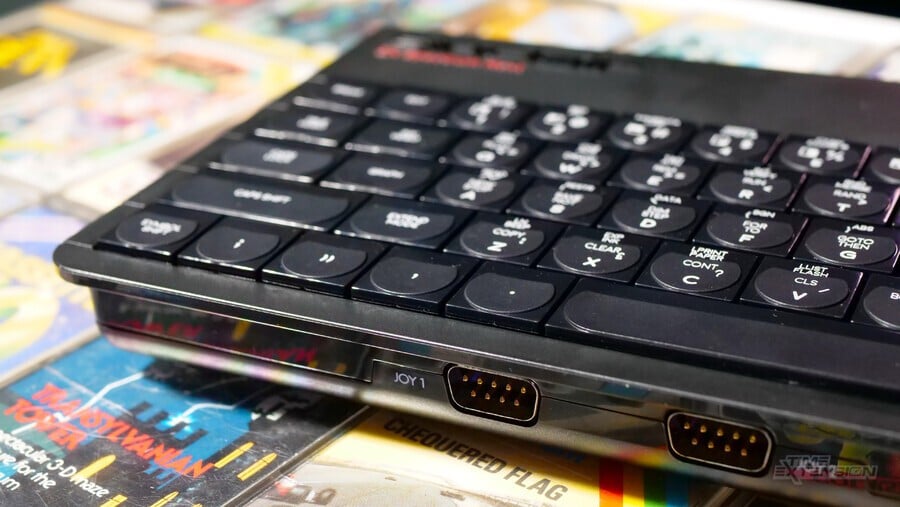
If you were looking for the ideal way to update a classic home computer, it's honestly hard to think of a more perfect example than the ZX Spectrum Next. The use of FPGA technology allows hardware-accurate performance, and being able to load up original games (via tape, if you wish) and plug in vintage accessories and expansion devices means the system is super-faithful to the original platform.
Add in upgraded performance for original games and a growing selection of Next-exclusive releases, and this computer becomes even more appealing. All of this is wrapped up in a package which factors in modern comforts such as HDMI-out and support for solid-state storage, achieving a streamlined user experience for those who simply want to revisit classic games from their childhoods.
The elephant in the room is that it's possible to obtain a similar experience to the Next via other means; clone systems exist, and there's a Spectrum Next core for the MiSTer FPGA project. You can emulate Next on your computer programs, such as Cesar Hernandez's ZEsarUX and Mike Dailly's #CSpect. Therefore, you've probably got a way of tapping into the Next ecosystem in your home already – and this is something the team behind the project positively encourage; the aim isn't necessarily to sell hardware (although that's clearly one of the objectives), but to ensure as many people are using the Next OS as possible so the community continues to grow.
The first two Kickstarter campaigns have placed 10,000 ZX Spectrum Next systems in people's hands, and this third campaign will add at least another 5,000 (if not significantly more). However, those are still relatively small numbers, which is why the team behind the venture is happy for people to seek out alternatives if they want the Next experience but don't have £300 handy.
Having said all of that, the ZX Spectrum Next is a product designed to appeal to lifelong Sinclair fans who want the full package in a nostalgia-inducing case designed by the late, great Rick Dickinson himself. It's for those who crave as authentic an experience as possible, right down to loading games on tape and connecting original Spectrum accessories. Looking to the future, the ability to add a Raspberry Pi-based Accelerator Board means you can augment the system's power in a cheap and easy fashion.
This really is a "new Spectrum" for the modern era and beyond, and not just an emulation-based micro-console stuck in the past; it celebrates the computer's amazing history whilst maintaining a focus on future classics yet to come. I can't imagine any self-respecting Speccy aficionado coming away disappointed, and who knows – this could even create a whole new generation of fans.
